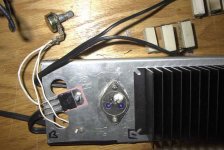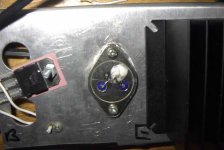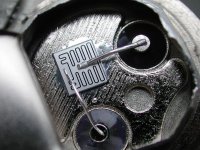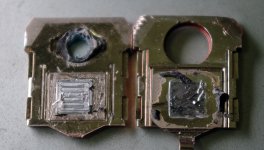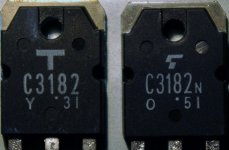I also forgot to mention that I just used a cheap pair of Radio Shack wire stripper to remove the cans of both.
I pinched the can between the cutters and they popped off, the NSC model was much harder but came off in the end.
I set up a test circuit this morning to see where exactly they failed and the nsc model went all the way to I guess my supply limit of almost to 20A @ about 4 volts.
I'm not sure what happened to the other one it got to just over 10a and blew up and melted both the emitter and base side wires going to the die? I thought it took my true On semi made tip3055 driver with it to ether when the base wires appeared to melt to the case but it still works a testament to a true non fake transistor.
So I believe the NSC model may be legitimate or at least a very good copy, but the other was definitely crap, which has been well documented before, but I just had to see for myself.
I pinched the can between the cutters and they popped off, the NSC model was much harder but came off in the end.
I set up a test circuit this morning to see where exactly they failed and the nsc model went all the way to I guess my supply limit of almost to 20A @ about 4 volts.
I'm not sure what happened to the other one it got to just over 10a and blew up and melted both the emitter and base side wires going to the die? I thought it took my true On semi made tip3055 driver with it to ether when the base wires appeared to melt to the case but it still works a testament to a true non fake transistor.
So I believe the NSC model may be legitimate or at least a very good copy, but the other was definitely crap, which has been well documented before, but I just had to see for myself.
Attachments
Easyamp said:So I believe the NSC model may be legitimate or at least a very good copy,
NSC did make some BJTs, as in protel dxp, you have nsc bjt lib.
also, wouldn't it be just easier to send a picture of the suspected fakes to OnSemi and let them confirm it?
I would suppose that as technology advances, you should be able to use smaller dies.
Hmm, doesn’t look like this company produces transistors. http://www.nsclocators.com/products/products_home.htm
I could be wrong of course.
I found this www.nanosemiconductor.com as well but I think they only make the pre-production.
Anyway, yesterday I happened to see a documentary about worldwide fake products.
I couldn’t believe my eyes and ears. Almost anything is copied these days. Not only expensive Rolex’s but literally anything you can think of, even medication. Quite frightening if you ask me.
/Hugo
I could be wrong of course.
I found this www.nanosemiconductor.com as well but I think they only make the pre-production.
Anyway, yesterday I happened to see a documentary about worldwide fake products.
I couldn’t believe my eyes and ears. Almost anything is copied these days. Not only expensive Rolex’s but literally anything you can think of, even medication. Quite frightening if you ask me.
/Hugo
here check out this link I found http://www.bizjournals.com/phoenix/stories/2001/05/07/daily78.html
or
http://www.findarticles.com/cf_dls/m4PRN/2000_August_30/64787645/p1/article.jhtml
It only refers to integrated electronics but If they have the means I thought maybe at some time in the past they made some single bipolars??
The hunt continues.
or
http://www.findarticles.com/cf_dls/m4PRN/2000_August_30/64787645/p1/article.jhtml
It only refers to integrated electronics but If they have the means I thought maybe at some time in the past they made some single bipolars??
The hunt continues.
wouldn't it be just easier to send a picture of the suspected fakes to OnSemi and let them confirm it
That's a good Idea. I still have a few left but I purchased these almost a year ago so I wonder what my chances are they could confirm these as ones they sold.
I would suppose that as technology advances, you should be able to use smaller dies.
I definitely agree that the die sizes will decrease as tech improves but to have to separate dies connected in parallel on the same device with no matching resistors doesn't seem like good design from the start. Even if they were consecutive off the disc they would not have the exact same characteristic and one would fail before the other and then take the other with it where a single would not.
is this fake mje340
on semiconductor
back
http://i33.tinypic.com/2ccrote.jpg
front
http://i38.tinypic.com/6okjzk.jpg
die
http://i34.tinypic.com/13zr4wn.jpg
on semiconductor
back
http://i33.tinypic.com/2ccrote.jpg
front
http://i38.tinypic.com/6okjzk.jpg
die
http://i34.tinypic.com/13zr4wn.jpg
Can't get to the site. But there are SO many makers of MJE340/350 these days. Units with logos that I've never seen before seem to work fine and test ok on VCEO and hfe, so I worry about those a lot less than the big power trannies. I do seem to get higher beta devices from ST than from any of the others - including ON.
AndrewT said:do the markings match those shown on the ONsemi datasheet?
I have a Fairchild, so can't check.
hi andrewt
no markings mentioned in the data sheet
i have blown 3 mje340 with rail of only +-42 volts
mje350 stays there ok made by cdil
wheares replacing them with bd139/40 the amplifier works well
This article was in a recent issue of Business Week.
http://www.businessweek.com/magazine/content/08_41/b4103034193886.htm
more fakes
http://search.businessweek.com/Search?searchTerm=fakes&resultsPerPage=20
http://www.businessweek.com/magazine/content/08_41/b4103034193886.htm
more fakes
http://search.businessweek.com/Search?searchTerm=fakes&resultsPerPage=20
I downloaded the ONsemi datasheet and the markings are completely different from your pic.ravslanka said:no markings mentioned in the data sheet
Re: Top Removal
The top is typically welded using a one shot machine. Obviously, their welding process control (if any) needs work, as they have inadequate weld power.
No. They were labelled correctly.
A "manufacturer" will produce millions of these devices and store them in one very large hopper.
When a purchase order is received, they will take whatever quantity they require from the hopper, and print the device type and manufacturer's logo specified on the purchase order on the lid. Then ship the units.
No test. No design. No QC. nuttin.
Simplicity itself. No need to worry about voltage, current, power, one size "fits all".
Sounds like the wires were 2 mil gold. The good part has aluminum, looks to be maybe 5 mil base and 10 or 15 mil emitter wire.
Well, the good part on the right seems to have a different feature at the mounting holes, the bad one looks like a simple stamped flat piece of metal. The base on the right is clearly more expensive to make, which is what the fakers avoid...I'd go with that.
Cheers, John
EchoWars said:Plus....how did the top come off??? Awfully clean removal...should be a ***** to get off..
The top is typically welded using a one shot machine. Obviously, their welding process control (if any) needs work, as they have inadequate weld power.
Frank Berry said:Perhaps the transistors were mis-labeled by the factory.
No. They were labelled correctly.
A "manufacturer" will produce millions of these devices and store them in one very large hopper.
When a purchase order is received, they will take whatever quantity they require from the hopper, and print the device type and manufacturer's logo specified on the purchase order on the lid. Then ship the units.
No test. No design. No QC. nuttin.
Simplicity itself. No need to worry about voltage, current, power, one size "fits all".
DieterD said:The wires were embedded in this and they were really thin, like one strand of a copper strand wire. ..
Sounds like the wires were 2 mil gold. The good part has aluminum, looks to be maybe 5 mil base and 10 or 15 mil emitter wire.
DieterD said:Problem is now I dont know whats good and whats not, I have a small drawer full of MJ15oxx's bought at different times and from different suppliers. They probably got them from the same distributer.
Any simple way of testing them without putting them in a amp? At least if they blow then they wont mess the rest of the amp.
DieterD
Well, the good part on the right seems to have a different feature at the mounting holes, the bad one looks like a simple stamped flat piece of metal. The base on the right is clearly more expensive to make, which is what the fakers avoid...I'd go with that.
Cheers, John
Easyamp said:I definitely agree that the die sizes will decrease as tech improves but to have to separate dies connected in parallel on the same device with no matching resistors doesn't seem like good design from the start. Even if they were consecutive off the disc they would not have the exact same characteristic and one would fail before the other and then take the other with it where a single would not.
As die attach technology and transient thermal testing got better, the ability to use smaller dies for the same function levelled off. Now, the die temp and the arrhenius equation tend to be the limiting factor.
It's possible to use the aluminum bonding wires as the emitter stabilization....solitron multi-emitter dies come to mind. But the biggest impact is gonna be the die attach integrity. With fakes, that is never an issue..
http://www.solitrondevices.com/General Catalog/Page C-108.pdf
Cheers, John
Can you tell me which of these two transistors is original and which is fake? Both are same model. The left one had some sticky transparent glue over the die, and the right one had no such thing, but had something like graphite die, which mostly left on the black package while I opened it. Here is the photo:
Attachments
Last edited:
I can't tell which is fake. Maybe both are made to meet the same specification.
Note the quite different way the collector lead is attached to the die.
All others details, although different in dimension, are very similar. Almost like they came from the same "head". Maybe one is a later development to improve reliability or to reduce production cost.
Note the quite different way the collector lead is attached to the die.
All others details, although different in dimension, are very similar. Almost like they came from the same "head". Maybe one is a later development to improve reliability or to reduce production cost.
- Status
- This old topic is closed. If you want to reopen this topic, contact a moderator using the "Report Post" button.
- Home
- Amplifiers
- Solid State
- More Fake Transistors
